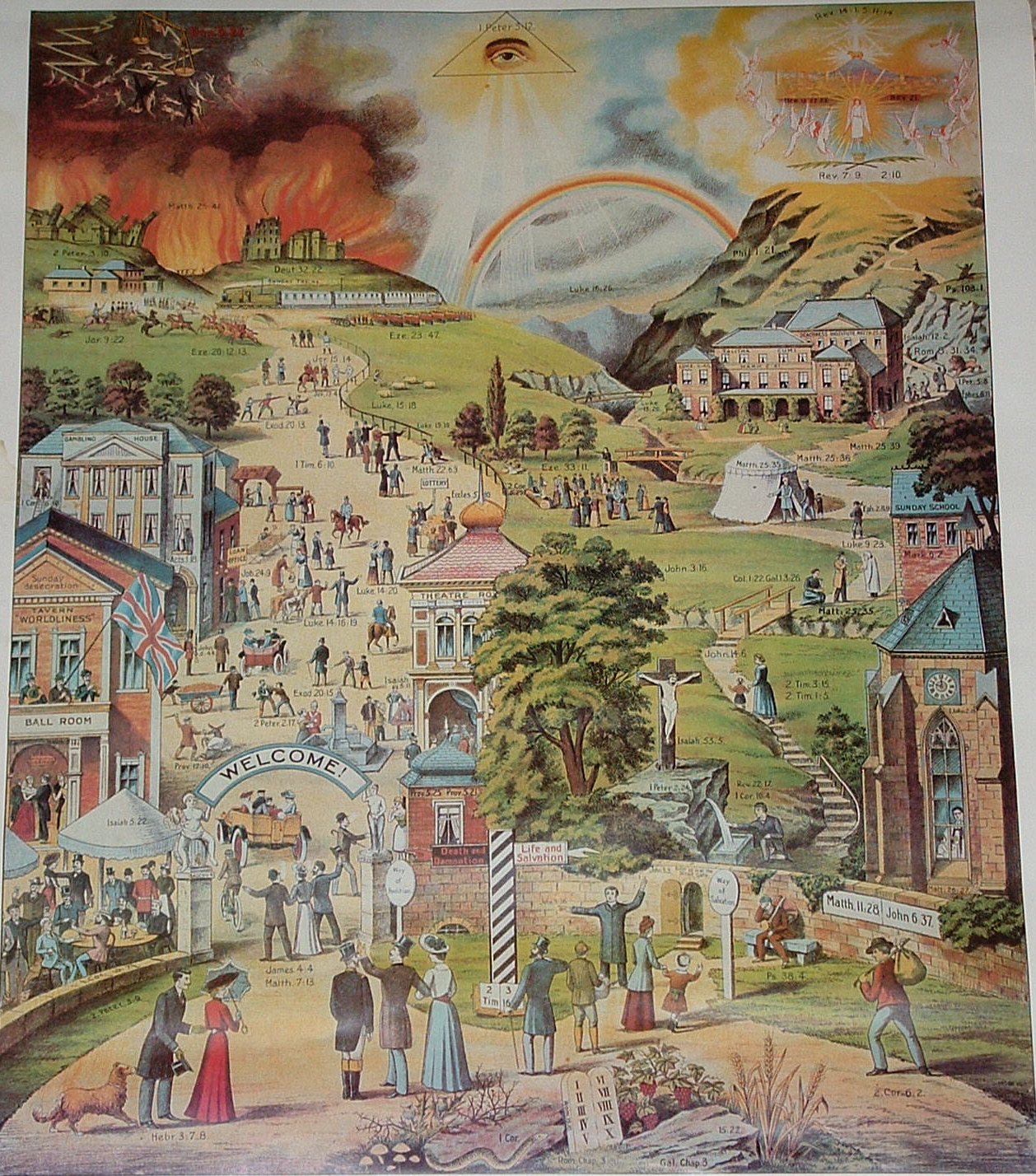This interesting picture comes from Germany by way of England in the Victorian era. It depicts the Biblical concept of the narrow way which leads to life: “Enter by the narrow gate. For the gate is wide and the way is easy that leads to destruction, and those who enter by it are many. For the gate is narrow and the way is hard that leads to life, and those who find it are few.” -Matthew 7:13-14
The broad way of life starting with indulgence pleasures and entertainment leading to vices, debauchery, wars, and destruction. This can be understood as simply a moral teaching of how to conduct ourselves, which is still useful as indulging in vices generates more karma, complications, and suffering.
Entering and staying on the broad path, or horizontal line of life is the way of unconsciousnessness, the pursuit of external pleasures which never result in a meaningful transformation of our soul (psyche). Without this rebirth into spirit the heaviness of our karma and egoic nature continues to return into this valley of tears. We perpetually postpone reunion with our internal Father.
The narrow way is smaller, harder to see, with less people entering it. The pilgrims on this way must confront the Christic path as seen by the crucified Christ just beyond the entrance. The stone below the cross pours the waters of life which are the purified and transmuted sexual waters. The crossroads, the choice between these two ways is always a sexual problem. Comprehending that sexuality is life and is the key to divine (inner) life transforms our entire orientation to being. By sacrificing the external orientation and connecting to the deep knowledge within, we are able to endure the narrow and rocky path which leads to liberation.
Explanation of the picture from the original booklet.
THE BROAD AND THE NARROW WAY.
Mrs Charlotte Reihlen
(Translated from the original German, by Miss Marriott, Mildmay Deaconess. )
This picture does not really need any explanation, inasmuch as for the most part that which is to be brought home and made important to the beholder speaks in symbolical, and therefore the plainest possible language.
Notwithstanding this, many will be glad to have a short general explanation, particularly of those objects and texts, which, owing to want of room, have been but partly given, and (as to the texts) with only the reference.
The reader will thus be spared the trouble of looking for the words. Further reflection is by no means excluded. The mystery of God’s kingdom and the mystery of iniquity, here represented by two paths, will become really clear only to those who keep the word of truth in an honest and good heart, and bring forth fruit with patience – (Luke 2:19 and 8:15)
The kingdom of this world will continue opposed to God’s kingdom, till the latter is fully triumphant.
The chief thought for contemplation is as the title shows, taken from the words of the Lord Jesus in His first public discourse to the people, in the Sermon on the Mount –
“Enter ye in at the strait gate: for wide is the gate, and broad is the way, that leadeth to destruction, and many there be which go in thereat: because strait is the gate, and narrow is the way which leadeth unto life; and few there he that find it.” Matt 7.13-14.
As Moses at the giving of the law from Sinai, and before they entered Canaan, put before the children of Israel blessing and cursing, death and life, so in like manner the foreground of our picture places them side by side.
On the right hand we see ears of corn and bunches of grapes, symbols of blessing and fruitfulness, at the same time suggestive of bread and wine, namely, the sacrament of the body and blood of the Lord Jesus, the second Adam.
On the left, thistles, thorns, and poisonous plants appear. These denote the curse which came through the sin of the first Adam, and the unfruitfullness of the earth, which the destructive Serpent sufficiently shows.
This at the same time points to the person of Satan, and his evil influence, as the author of all sin. In the midst of this group, shut in by blessing and cursing, and, though ordained to life, containing both life and death, are the tables of the Law; while to the right and left of them, on two rocks, are engraven words which tell us of man’s terrible fall, and God’s plan of redemption designed from all eternity:— (1) ” As in Adam all die (2) even so in Christ shall all be made alive.” – 1 Cor, 15:22.
On the two tables of the law are the ten commandments, the duties of the love that we have to practice towards God and man. Man’s position in regard to the Divine law is shown by two important passages of Scripture, Romans Ch 5. and Galatians Ch 3, which prove that non-fulfilment of the law condemns us in God’s sight.
On the other hand, the sinfulness and ruin of our fallen nature, of which we first become conscious through these commands, as also the experience that we are unable, with all our efforts, to keep them so completely as to satisfy God, these drive us to God in Christ.
“The law was our schoolmaster to bring us unto Christ, that we might be justified by faith.”— (Gal. 3:24.)
Since Jesus alone has fulfilled the law out of Divine love for us, and for our benefit, and in His redemptory offering and blood-shedding has atoned for our sins, and suffered for us, we can only by repentance (ie, change of mind) and by faith in His merit be justified, and filled with the spirit of love, which then enables us to keep the commandments; because nothing is hard to unselfish, God wrought love, and grace is then much more powerful than sin.
The text in our picture, written on the tables of the law, refers to this: “Love worketh no ill to his neighbour: therefore love is the fulfilling of the law.”— Romans 13:10.
The foreground of our picture, as above described, is occupied with a descriptive representation, comprehensive and universal, referring to all men without exception.
It leads us at once to the place of decision that is so near, and at the same time shows us the great difference between the two gates and the two ways. For evidently the people, standing on the common entrance ground, of high or low rank, old or young, men or women, nobles, burghers, or peasants, are preparing to set out in one direction or the other.
Yet before doing so they turn to the wooden sign-post standing in the middle, painted with alternate bright and dark stripes, as if to indicate that the choice of one of the paths leads to the joyous light of everlasting day, but the other to the sad darkness of the hopeless night of despair.
The two arms of the sign-post express this further in a most unmistakable manner, as one of them is turned towards an open and very narrow gate, and bears the inscription — “Life and Salvation.” whereas the other is directed towards a beautiful, wide-open portal, and bears the inscription — “Death and Damnation.”
The large open Bible at the foot of the signpost shows the following texts:—”Search the Scriptures, for in them ye think ye have eternal life: and they are they which testify of me,”—{John 5:39.) “All Scripture is given by inspiration of God, and is profitable for doctrine, for reproof, for correction, for instruction in righteousness; that the man of God may be perfect, thoroughly furnished unto all good works.” — (2 Timothy. 3:16-17.)
These explain to us that the Scriptures, of God’s written revelation to man, show us the unveiled truth, and are at the same time the touchstone to prove if a soul be really of the truth or not; if it turn rather to darkness, which for the moment has something apparently good and attractive, or if it turn to the light, which particularly at first for the outward natural man, requires self denial.
Above all, this whole scene represents that point of time, or that period of life, in which, to every man, the truth is brought so near that, in a decided manner, he turns either to good or evil, either to the “kingdom of God” or to the “kingdom of the world” even though he be a heathen; because, even in such an one, although by no means with the clearness and responsibility of Christian knowledge, God does not leave Himself without the witness of conscience.—(Romans 2.)
If the glad news of the Gospel is brought home to us by a preacher, as in our picture is the case, this is a special favour that does not by any means happen to all men, for “Faith cometh by hearing.” —(Romans 10:17)
God’s will concerning us is declared by the texts introduced in various places, as “Behold now is the accepted time; behold now is the day of salvation,” (2 Corinthians 6:2.) “Today, if ye will hear His voice, harden not your hearts.”—{Hebrews 3:7-8) “The Lord is not willing that any should perish, but that all should come to repentance —(2 Peter 3:9) “Who will have all men to be saved, and to come unto the knowledge of the truth,”—(1 Timothy 2:4)
Above all the preacher points on the one hand to the words, “He that believeth on the Son hath everlasting life: and he that believeth not the Son shall not see life, but the wrath of God abideth on him’ — (John 3:36) while on the other hand he brings out the great importance of the warning, “Except a man be born again, he cannot see the kingdom of God” – John 3:3.
This appears to have brought several persons to serious thought; among others, a young man with a burden on his back sinks down on a seat, exclaiming, “Mine iniquities are gone over mine head; as a heavy burden they are too heavy for me.” (Psalm 38:4) He is comforted by the words, “Come unto Me, all ye that labour and are heavy laden, and I will give you rest — (Matt 11:28)— and “Him that cometh to Me, I will in no wise cast out” (John 6:37.)
The greater part, (particularly of the noble and rich, turn to the showy open gate on the left, and the two ways now separate.

